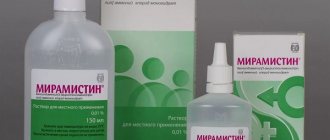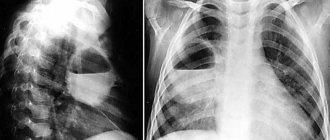Laryngitis is an inflammatory disease of the larynx, which is one of the consequences of influenza, ARVI, whooping cough, scarlet fever, rhinitis, tonsillitis, and pneumonia.
With laryngitis, the vocal cords are the first to suffer - the patient’s voice becomes hoarse or disappears altogether. Breathing becomes difficult, and a so-called “barking” cough appears, which is quite painful.
Laryngitis in adults can also occur as an independent disease, for example, when the voice is overstrained (the so-called “teacher’s disease”).
It is customary to distinguish between acute and chronic laryngitis .
1
Diagnosis of laryngitis in MedicCity
2 Diagnosis of laryngitis in MedicCity
3 Diagnosis of laryngitis in MedicCity
Anatomy of the larynx
The larynx is a complex organ, which is a complex of various tissue structures with a developed network of blood, lymphatic vessels and nerves.
The larynx is a hollow air-carrying organ, which is given rigidity by cartilage. The larynx opens from above into the laryngopharynx, and from below it passes into the trachea.
Inside, the larynx is covered with a thin mucous membrane of cylindrical ciliated epithelium, and in places of mechanical load (epiglottis, posterior wall of the larynx, free edges of the vocal folds) with more durable stratified squamous epithelium.
The skeleton of the larynx consists of 5 main cartilages:
- three unpaired (cricoid, thyroid and epiglottis);
- two paired (arytenoid cartilages);
The vocal folds are two muscular-ligamentous cords of a whitish-pearl-colored color.3
The larynx provides a number of important functions:
- respiratory
- phonatory (voice)
- protective
- cough
- expectorant
- speech-forming (it is based on respiratory and vocal functions)
Causes of laryngitis
The cause of croup is most often a viral infection:
| CAUSES | A COMMENT | ||
| causes: | Infections | a comment: | The cause of acute laryngitis can be an infection that penetrates the mucous membrane of the pharynx and larynx and is easily activated against the background of a decrease in general and local immunity. The main causative agents of acute and chronic laryngitis include mainly streptococci and staphylococci, which can be activated under the influence of unfavorable factors. |
| causes: | Non-infectious causes | a comment: | — smoking and alcohol — chemical and thermal burns of the larynx — allergies — severe vocal strain |
Risk factors for developing acute laryngitis:
- decreased immunity
- general and local hypothermia
- diseases of the pharynx and paranasal sinuses
- influence of bad habits
Acute inflammation of the mucous membrane of the larynx may be a consequence of catarrhal inflammation of the nasal mucosa, paranasal sinuses (sinusitis) or pharynx (tonsillitis, pharyngitis).
Acute laryngitis develops against the background of viruses:
- ARVI
- influenza A, B, and C viruses
- parainfluenza
- adenovirus infection4
Among bacteria, common causative agents of acute laryngitis are:
- Haemophilus influenzae (H. Influenzae)
- chlamydia pneumoniae
- Moraxella catarrhalis
- pneumococcus (S. pneumoniae)5
How to avoid getting laryngitis
To protect yourself as much as possible from the development of laryngitis, you need to follow simple rules:
- eliminate bad habits, especially smoking;
- exercise;
- to live an active lifestyle;
- eat a balanced diet;
- keep the premises clean, regularly ventilate, moisturize;
- do not visit crowded places during periods of epidemics;
- avoid environmentally unfavorable habitats.
Compliance with these standards will not completely protect against laryngitis, but the risk will be minimized.
Classification of acute laryngitis
Catarrhal laryngitis
The most common form of the disease. Acute laryngitis is characterized by catarrhal inflammation of the laryngeal mucosa without signs of stenosis. Catarrhal laryngitis is the simplest form of laryngitis, which is treated on an outpatient basis
Edema laryngitis
Characterized by swelling of the mucous and submucosal layer of the larynx. Clinical manifestations of edematous laryngitis depend on the size of the edema. The causes are angio-neurotic (Quincke's edema) and allergic.
Phlegmous laryngitis (abscess)
Acute laryngitis with the formation of an abscess in the area of the epiglottis or aryepiglottic folds.
Drug therapy
How to fight infection?
Drug therapy for laryngitis that appears in a child against the background of an acute respiratory infection includes the use of antiviral and immunomodulatory drugs.
Antihistamines, which are usually prescribed for allergies, help relieve swelling of the mucous membrane and calm the baby. They should be given before bedtime, strictly according to the recommendation of the attending physician. What to do if you have a cough?
Remedies for this symptom are another essential component of treatment.
In the early stages of laryngitis, if a child has a dry hacking cough, drugs that block the cough center are used. Next, at the first signs of coughing, mucolytics are prescribed to thin the mucus and improve expectoration of sputum. Doctor MOM® cough syrup has similar properties. This complex herbal medicine, containing extracts of 10 medicinal plants, helps not only to liquefy mucus, but also to relieve swelling and inflammation. Herbal syrup is approved for long-term use in the treatment of laryngitis in children over 3 years of age. Actions at temperature.
If a child has a hard time tolerating a high temperature, he is prescribed an antipyretic. Treatment of laryngitis with antibiotics is justified only in the presence of serious bacterial complications and only as prescribed by a doctor.
Symptoms of acute laryngitis
With the catarrhal form of laryngitis, the following complaints are observed:
- a sore throat
- sore throat
- hoarseness, hoarseness, loss of voice
- dry or wet cough
- difficulty breathing when inhaling
- dyspnea
- deterioration in general health, headache, weakness
- increase in body temperature to 37.1-38.06
Symptoms of laryngitis in phlegmonous (asbestos) form::
- difficulty swallowing
- dyspnea
- febrile temperature (38-39 degrees) reflects the addition of inflammation or the transition of catarrhal inflammation of the larynx to phlegmonous
- there is increasing symptomatology of laryngeal stenosis
How many days does the temperature last for laryngotracheitis?
Characteristic signs of laryngotracheitis include cough, change in voice (dysphonia), pain in the chest and throat, fever, general weakness, and enlarged lymph nodes.
Cough. It is characterized as dry, “barking” without sputum production. Eating or talking can trigger a coughing attack.
Dysphonia. With laryngotracheitis, the voice is hoarse, hoarse, and sometimes completely disappears.
How many days does the temperature last for laryngotracheitis? In the chronic form, the temperature remains at low-grade levels for the first three to four days.
Chest pain. Painful sensations usually intensify during coughing. The doctor will tell you during your consultation what to do during a coughing attack with laryngotracheitis and how to prevent its onset.
Possible complications are bronchitis, bronchiolitis, pneumonia (pneumonia), false croup. The most severe include: laryngeal ulcers, laryngeal ventricular prolapse, benign neoplasms.
Acute respiratory failure with laryngitis
The severity of clinical manifestations is directly related to the severity of inflammatory changes.
The main symptom of acute respiratory failure is shortness of breath. The following degrees are distinguished depending on severity:
- I degree of respiratory failure – shortness of breath that occurs during physical exertion.
- II degree – shortness of breath that occurs with little physical activity (slow walking, washing, dressing).
- III degree – shortness of breath at rest.7
Clinical picture of acute laryngitis upon examination
The main method for diagnosing laryngitis is instrumental and endoscopic laryngoscopy.
For catarrhal laryngitis:
- the mucous membrane of the larynx is red and swollen
- vocal folds are pink or bright red, thickened, mobile, do not close completely
- mucous or mucopurulent secretions may accumulate, which can cause a wet cough
Depending on the form of acute laryngitis, swelling and hyperemia (red mucous), the size of the epiglottis, and narrowing of the lumen of the larynx can be expressed in different ways.
In the complicated (abscessing) form, a spherical formation with translucent purulent contents is determined in the area of the epiglottis.
With stenosis of the larynx, a narrowing of its lumen occurs.
Treatment of laryngotracheitis in adults
Timely and qualified treatment will avoid many complications. The goal of therapy is to relieve swelling and eliminate the pathogen. For this purpose, antibiotics, special drugs for viral laryngotracheitis, expectorants, antihistamines, anti-inflammatory and antipyretic drugs are prescribed. Homeopathic medicines would be a good addition.
Ethnoscience. Doctors recommend taking herbal decoctions with an expectorant effect and gargling. Tea with ginger root and honey has worked well.
In severe cases of chronic laryngotracheitis, in the absence of results from conservative therapy, experts recommend surgical treatment. The specialist will tell you more about the indications and progress of the operation in a private conversation.
Laryngeal stenosis
According to the clinical course and size of the airway lumen, four degrees of laryngeal stenosis are distinguished:8
- Stage of compensation - the lumen of the glottis is 6-8 mm or the narrowing of the tracheal lumen by 1/3
- Stage of subcompensation - glottis 3-4 mm, tracheal lumen narrowed by ½ or more
- Stage of decompensation - glottis 2-3 mm, slit-like lumen of the trachea
- Asphyxia - glottis and/or tracheal lumen 1 mm
!A thorough examination of the larynx can only be performed by an otorhinolaryngologist. The patient cannot independently examine himself and assess the severity of the condition.
Diagnostics
When treating laryngitis, first of all, an otolaryngologist performs an initial diagnostic examination using laryngoscopic instruments and mirrors, and takes smears for laboratory analysis.
If necessary, a detailed assessment of the condition of the larynx is carried out using a rigid telescope, which magnifies the image of the pathological area.
At the next stage, a biopsy may be performed. Additionally, a general blood and urine test is prescribed. Based on the results of the study, the otolaryngologist sees the full clinical picture of the disease and prescribes the necessary therapy.
Treatment of acute laryngitis 9
Treatment of acute laryngitis requires an integrated approach.
Antibacterial therapy
Antibacterial therapy is not required for patients with mild forms of laryngitis. In case of severe inflammatory phenomena, with complicated forms of acute laryngitis, with the development of an abscess, as well as with exacerbations of chronic laryngitis, broad-spectrum antibacterial drugs (amoxicillin/clavulanic acid, cephalosporins of III–IV generations) or respiratory fluoroquinolones are prescribed.
Symptomatic therapy
Includes taking antipyretic and painkillers.
Inhalation therapy
Indicated for patients with any form of laryngitis, including abscesses.
Inhalations can be used as monotherapy for uncomplicated forms of laryngitis, as a symptomatic treatment to moisturize the laryngeal mucosa, and also in combination with other treatment methods for inflammatory diseases of the larynx.
In inhalation form, drugs are used that have antibacterial, antifungal, decongestant, mucolytic, anti-inflammatory effects, as well as the ability to moisturize the mucous membrane.
The main advantage of inhalations is the ability to achieve a quick and effective therapeutic effect using a small dose of the drug with a significant reduction in the negative systemic effect. During inhalation, drugs are rapidly absorbed. A high concentration of the drug is created directly at the site of inflammation.
Antihistamines
Prescribed for allergic forms of acute laryngitis.
Anti-edematous and anti-inflammatory therapy
Antifungal drugs are prescribed when a fungal infection is diagnosed.
Mucolytic drugs
Other treatment recommendations:
- vocal rest - it is recommended to talk as little as possible, avoid shouting, loud speech and whispering
- gentle diet - it is not recommended to eat spicy, salty, too hot or cold foods
- quitting smoking and alcohol
If treatment is ineffective or complications occur, hospitalization is indicated. If necessary, surgical intervention is performed.
Indications for emergency hospitalization are complications of acute laryngotracheitis:
- edematous laryngitis
- epiglotite
- abscesses of the epiglottis, complicated forms of the disease (infiltrative and abscessive)
- threat of developing laryngeal stenosis
After an illness, the recovery period lasts 2 weeks. When undergoing surgery, observation by an otolaryngologist for several months is recommended.
Complications
Most often, the pathogen can spread to other organs. This can often lead to heart complications. It is difficult to restore normal functioning of the cardiovascular system after this type of complication.
Often, the consequences can affect other parts of the upper respiratory tract or even spread to the lungs, thereby greatly complicating symptoms and treatment.
It is a mistake to believe that this disease can go away on its own. Also, you should not turn to alternative medicine, which can harm your health if not agreed with a specialist. Self-medication is not the best, since the cause of the disease can be various microorganisms, as well as medications that helped in one situation, but in another can even worsen the disease.
Remember: frequent colds or cases of laryngitis may be the first symptom of immunodeficiency!
Acute form
With an exacerbation of the disease, the symptoms also worsen: the cough becomes even drier and debilitating, enlargement of the cervical lymph nodes with irradiation of pain in the ear can be a concomitant disease with sore throat and scarlet fever.
Chronic form
It occurs when not only the upper and lower respiratory tracts are affected, but also other organs. It has the greatest effect on the heart, so disturbances on its part are possible - tachycardia, arrhythmia. This may be due to direct damage to the organ, or may cause incorrect innervation of the vagus nerve, which provides a conduction system not only to the heart, but also to the diaphragm and intestines. Accordingly, various gastrointestinal disorders associated with its poor, inactive functioning are possible.
Prevention of acute laryngitis
- giving up bad habits such as smoking, drinking alcohol. These factors often cause the process to become chronic
- respiratory protection when working with chemicals
- timely diagnosis and treatment of diseases of the ENT organs, such as sinusitis, pharyngitis, tonsillitis
- prevention of ARVI and other viral diseases
There are individual prevention measures aimed at strengthening the body’s protective properties:
- avoiding general and local hypothermia
- hardening the body, exercising, regularly spending time in the fresh air
- consuming enough vitamins from food
- consumption of vitamins and dietary supplements (BAS), rich in various vitamins, minerals, nutrients, and substances of plant origin to strengthen health and immunity, and prevent colds.
Tantum® Propolis
It is important to choose the right biological supplement, focusing on the body’s needs and its problem.
For example, Tantum® Propolis lozenges can help strengthen the immune system. 16 Find out more
Not being a medicine, Tantum®Propolis can support the patient’s immunity during seasonal ARVI and influenza, reduce pain, irritation and itching in the throat, and also replenish the lack of vitamins in the patient’s body.
Factors that aggravate the disease and its treatment
Treatment has low effectiveness in the presence of some external harmful factors, such as smoking, inhalation of harmful substances (among miners, workers in the heavy and chemical industries). An important role in the complication of the disease during its treatment is played by reduced immunity, for example, with HIV or AIDS or congenital immunodeficiency.
In order to recover from the disease faster, try to reduce negative factors as much as possible, stop smoking, stay in bed, and most importantly, follow the instructions of your doctor.
FAQ
How to treat laryngitis at home?
For uncomplicated acute laryngitis and in the first days of the disease, it is recommended:
- ensure vocal rest, eliminate whispered speech , in which the vocal folds become even more tense
- plenty of warm drinks: you can drink warm milk with soda, warm mineral degassed water, teas and fruit drinks
- if laryngitis is accompanied by inflammation in the throat, it is recommended to rinse with a solution of chamomile or calendula, as well as the use of sprays, solutions or tablets to treat the throat
- inhalations are the main method of treating laryngitis. Self-inhalation can only be done using saline solution. Other drugs for inhalation are prescribed exclusively by a doctor.
Is it possible to quickly cure laryngitis?
For acute catarrhal laryngitis caused by viruses, recovery is possible within a week. It is important to consult a doctor in time and not self-medicate so as not to worsen the condition.
What syrups and tablets can be taken for laryngitis?
The use of local drugs for the treatment of the throat in the form of lozenges, sprays and rinses is permissible only if laryngitis is caused by throat diseases. These forms of drugs do not directly enter the lumen of the larynx.
How to treat false croup in a child?
When the first symptoms of croup appear, you should call an ambulance.
Only a doctor will be able to assess the severity of the child’s condition, as well as determine further treatment and observation tactics. Outpatient observation and treatment is permissible only for grade 1 stenosis. Self-medication and the use of folk remedies are excluded in this case!
How to relieve allergic swelling of the throat
In case of allergic edema, including Quincke's edema, you need to act immediately. The first step is to call an ambulance. Then all possible allergens are removed from the patient, the room is ventilated and humidified. The sick person must be seated and cannot lie down. Give orally, or even better, inject an antihistamine (Diphenhydramine, Suprastin).
Upon the arrival of doctors, hormonal drugs (Prednisolone, Dexamethasone) are administered, and it is even possible to prescribe Adrenaline in advanced cases.
If the swelling does not stop with hormones and antihistamines, but increases even more, the patient is given a tracheostomy until the swelling goes away. This is necessary to prevent suffocation. It is also practiced to put the patient into medicated sleep, but in rare cases.
How to relieve allergic swelling of the throat.










